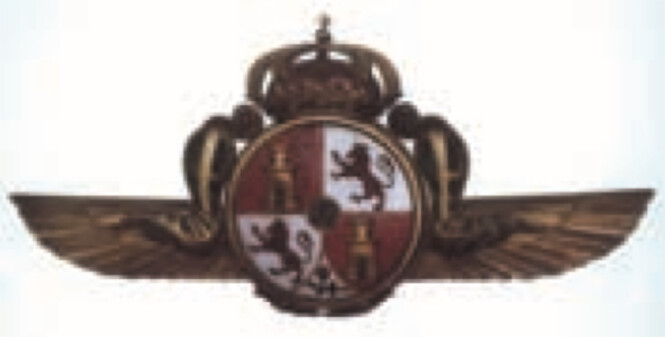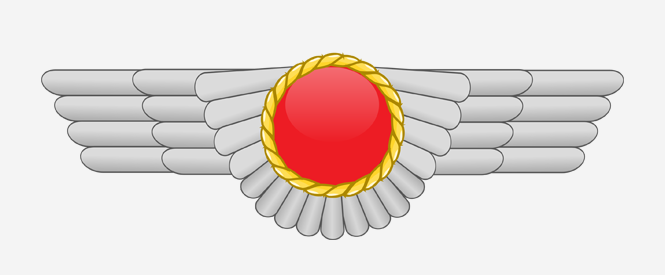History of the Rokiski, insignia of the Spanish Air Force with Polish name and Egyptian origin
In addition to the red and yellow cockade and the Saint Andrew's cross that its aircraft display in the drifts, the Spanish Air Force is recognized by a curious winged emblem with a red circle.
This insignia, known as "Rokiski", was established by the Regulations of the then called Aeronautical Service, approved by Royal Order of April 16, 1913, which said the following: "The personnel of the aeronautical service will wear on their uniform the emblem of Aeronautics: two silver wings with a red disk in the middle and a Royal Crown on top. This emblem will be made of metal for soldiers and troop classes, who will wear it on the left arm; embroidered for chiefs and officers, who will wear it on the right side at the level of the first button of the jacket."
An emblem of Egyptian origin drawn by an English Infanta
This emblem was designed at the home of Infante Alfonso de Orleáns y de Borbón, pilot of the Aeronautics Service, in a meeting of officers in which the need for an emblem for said service was addressed. Infanta Beatriz of Saxony, born in England, wife of the Infante, connoisseur of Egyptian culture and excellent draftsman, was at that meeting and drew a winged emblem with a red disk inspired by a emblem of ancient Egypt.

According to Cecilio Yusta Viñas in "La Aviación Militar española, nacimiento y desarrollo inicial" (Spanish Military Aviation, birth and initial development, Revista Aeroplano nº29, 2011), the Infanta may have been inspired by an Egyptian-inspired emblem that was in the Montpensier Palace, then owned by the Infante of Orleáns and built in the mid-19th century in Sanlúcar de Barrameda (Cádiz), which you can see below these lines.

As you can see below these lines, the Rokiski of the Spanish Air Force has a great resemblance to an emblem that symbolized protection and was formed by the eye of the god Ra and the wings of the god Horus. Today in Today that insignia can be seen in the Temple of Ramesses III at Medinet Habu.

The aforementioned Regulation already provided for the use of gold insignia on the red disk: an anchor for balloon pilots, a rudder for airship pilots and a four-bladed propeller for airplane pilots. The first Rokiski was made in the Ansorena jewelry store in Madrid (which still exists), and was given to King Alfonso XIII.

The different changes in the timbre of the emblem
During the Second Republic, the royal crown of the Rokiski was suppressed (between 1931 and 1934), and later a mural crown was placed on the bell and it was even left without any crown. During the Civil War, the Republican side placed a red five-pointed star on the Rokiski.


During the war, the national side put an eagle of San Juan on the red disk and a royal crown open to the bell, and later suppressed the eagle and left the red disk with the insignia of specialties, as in the beginning.

The origin of the Polish name of the Spanish Air Force insignia
It was during the post-war period when this emblem began to be known as "Rokiski", since it was the surname that appeared on the obverse of the insignia made between 1939 and 1965 by the goldsmith José Luis Rokiski Gómez, a Spaniard with a Polish surname and origin, grandson of Félix Rokiski and Fablonski, a soldier who arrived in our country in 1835 - he was then a cadet of the famous Polish cavalry -, putting himself at the service of Spain and fighting in the Carlist Wars alongside the liberal side, reaching the rank of Brigadier (equivalent to the current Brigadier General).

With the arrival of democracy, the Rokiski recovered its original design with the royal crown closed. It should be noted that today it is not only used by the Spanish Air Force, but also by the Army, the Navy and the Civil Guard, specifically those of its members who have passed the parachuting course at the Military Parachuting School of the Spanish Air Force in Alcantarilla (Murcia). In these cases the Rokiski is carried with a parachute over the red disc.
I leave you here with a video about the Rokiski that was presented yesterday by the Air Force at the 2019 Aire Awards gala. If I'm not mistaken, its author is the youtubber Memorias de Pez, whose channel I recommend to all history fans (the video is in Spanish, you can activate the automatic English subtitles in the bottom bar of the player):
|
Don't miss the news and content that interest you. Receive the free daily newsletter in your email: |
- Most read
- A report that shows how a Boeing B-52 Stratofortress strategic bomber works
- Princess Leonor at the Naval Military School and some notes on the female cap
- An excellent documentary shows the inside of the B-17 Flying Fortress bomber
- Sierra Army Depot, a huge United States base with hundreds of Abrams tanks stored
- Poland is now a little closer to becoming the first European operator of the F-15 fighter
- The firearms used by the Pontifical Swiss Guard, the smallest army in the world
- Eurofighter vs F-35: the opinions of professional pilots on these advanced fighters

 ES
ES







Opina sobre esta entrada: